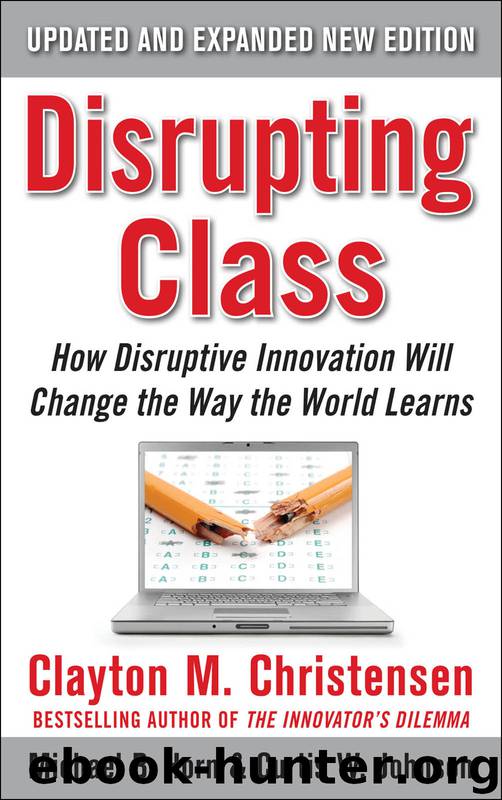Disrupting Class by Clayton M. Christensen & Michael B. Horn & Curtis W. Johnson

Author:Clayton M. Christensen & Michael B. Horn & Curtis W. Johnson
Language: eng, eng
Format: epub, mobi
Publisher: McGraw-Hill
Published: 2011-03-25T16:00:00+00:00
DISRUPTING THE VALUE NETWORK
A value network is the context within which a firm establishes its cost structure and operating processes and works with suppliers and channel partners to respond profitably to customers’ common needs. The reason the whole value network must be replaced for a disruption to occur is that, in each stage, the actors’ business models, economic incentives, and rhythms of innovation and technological paradigms are consistent and mutually reinforcing. Companies with disruptive economics simply are not plug-compatible with the old value network.1 What this means is that the entire system for creating education materials, making the decisions about which materials to adopt, and delivering the content to students must and will change.
Here’s a simple example to illustrate why. As we discuss in Chapter 3, the transistor was disruptive to the vacuum tube because it couldn’t handle much power. Hence, transistors couldn’t be used to make large products—the sorts of floor-standing televisions and tabletop radios that the leading consumer electronics companies of the day, such as RCA and Zenith, made. These companies built their products with vacuum-tube technology and sold them through appliance retailers. Appliance stores made most of their money not from selling televisions and radios, but from repairing the burned-out vacuum tubes in the products they had sold. (Those of our readers with a few flecks of grey hair will remember that TVs and radios in that era were disabled with maddening frequency when a random vacuum tube burned out.)
When Sony developed the world’s first miniature transistor radio in 1955 and the portable television four years later, it tried to distribute them through appliance stores, too. But the appliance stores wouldn’t give the time of day to Sony. Why? Because Sony’s solid-state products contained no vacuum tubes that would burn out. Luckily for Sony, however, discount retailers such as Kmart, Wal-Mart, and Target were emerging at that time, and they had not been able to sell vacuum-tube-based products because they couldn’t service them in the aftermarket. It was a marriage made in heaven—products that needed no service sold through a channel that could offer no service. By the mid-1960s, solid-state electronics had progressed to the point that they could handle the power large televisions needed. In the ensuing transition it wasn’t just Sony and Panasonic that disrupted RCA and Zenith; the miniaturized solid-state component suppliers disrupted the high-power component makers, and the discount sales channel disrupted the appliance stores. An entire value network disruptively displaced an entire value network.
Download
Disrupting Class by Clayton M. Christensen & Michael B. Horn & Curtis W. Johnson.mobi
This site does not store any files on its server. We only index and link to content provided by other sites. Please contact the content providers to delete copyright contents if any and email us, we'll remove relevant links or contents immediately.
Weapons of Math Destruction by Cathy O'Neil(6147)
Cracking the GRE Premium Edition with 6 Practice Tests, 2015 (Graduate School Test Preparation) by Princeton Review(4227)
What It Really Takes to Get Into Ivy League and Other Highly Selective Colleges by Hughes Chuck(3697)
Fooled by Randomness: The Hidden Role of Chance in Life and in the Markets by Nassim Nicholas Taleb(3046)
The Tyranny of Metrics by Jerry Z. Muller(3003)
The Marketing Plan Handbook: Develop Big-Picture Marketing Plans for Pennies on the Dollar by Robert W. Bly(2977)
Ultralearning by Scott Young(2890)
The Official Guide for GMAT Review 2015 with Online Question Bank and Exclusive Video by Graduate Management Admission Council (GMAC)(2759)
50 Economics Classics by Tom Butler-Bowdon(2524)
Bull by the Horns: Fighting to Save Main Street From Wall Street and Wall Street From Itself by Sheila Bair(2125)
The Visual MBA by Jason Barron(2099)
The Inevitable by Kevin Kelly(1929)
Data Science for Business by Foster Provost & Tom Fawcett(1907)
Cracking the LSAT, 2012 Edition by Princeton Review(1886)
Out of the Crisis by Deming W. Edwards(1845)
GMAT Official Guide 2018 Verbal Review by GMAC (Graduate Management Admission Council)(1810)
The Personal MBA: Master the Art of Business by Josh Kaufman(1774)
The Conflict Resolution Phrase Book by Barbara Mitchell & Cornelia Gamlem(1735)
Maths and Stats for Web Analytics and Conversion Optimization by Himanshu Sharma(1657)
